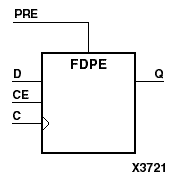| XC3000 | XC4000E | XC4000X | XC5200 | XC9000 | Spartan | SpartanXL | Virtex |
|---|---|---|---|---|---|---|---|
| N/A | Primitive | Primitive | Macro | Primitive | Primitive | Primitive | Primitive |

FDPE is a single D-type flip-flop with data (D), clock enable (CE), and asynchronous preset (PRE) inputs and data output (Q). The asynchronous PRE, when High, overrides all other inputs and sets the Q output High. Data on the D input is loaded into the flip-flop when PRE is Low and CE is High on the Low-to-High clock (C) transition. When CE is Low, the clock transitions are ignored.
For FPGAs, the flip-flop is asynchronously preset, output High, when global reset (GR for XC5200) or global set/reset (GSR for XC4000, Spartans, Virtex) is active. The active level of the GR/GSR defaults to active-High but can be inverted by adding an inverter in front of the GR/GSR input of the STARTUP or the STARTUP_VIRTEX symbol.
For CPLDs, the flip-flop is asynchronously cleared, output Low, when power is applied. The power-on condition can be simulated by applying a High-level pulse on the PRLD global net.
For XC9500XL devices, logic connected to the clock enable (CE) input is unconditionally implemented using the clock enable product-term of the XC9500XL macrocell. Only FDCE and FDPE flip-flops use the XC9500XL clock enable product-term.
| Inputs | Outputs | |||
|---|---|---|---|---|
| PRE | CE | D | C | Q |
| 1 | X | X | X | 1 |
| 0 | 0 | X | X | No Chg |
| 0 | 1 | 0 | 0 | |
| 0 | 1 | 1 | 1 | |
Figure 5.18 FDPE Implementation XC5200 |